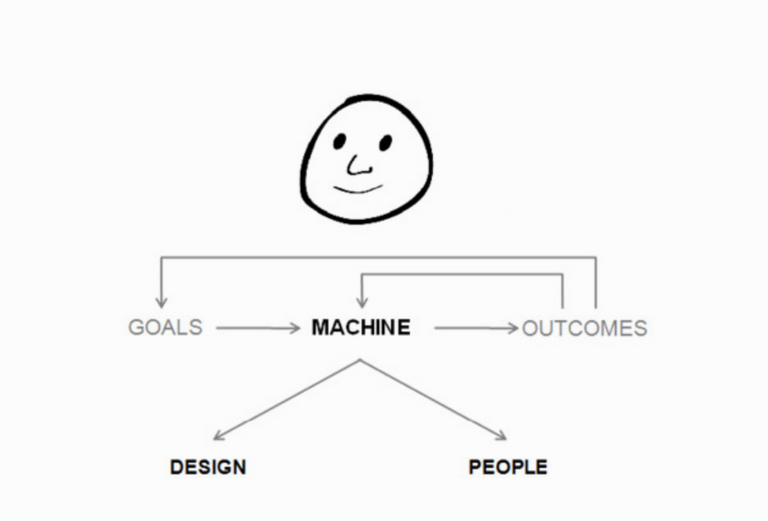
Those who are most successful are capable of “higher level thinking” —i.e., they are able to step back and design a “machine” consisting of the right people doing the right things to get what they want. They are able to assess and improve how their “machine” works by comparing the outcomes that the machine is producing with the goals. Schematically, the process is as shown in the diagram below. It is a feedback loop:
That schematic is meant to convey that your goals will determine the “machine” that you create to achieve them; that machine will produce outcomes that you should compare with your goals to judge how your machine is working. Your “machine” will consist of the design and people you choose to achieve the goals. For example, if you want to take a hill from an enemy you will need to figure out how to do that— e.g., your design might need two scouts, two snipers, four infantrymen, one person to deliver the food, etc. While having the right design is essential, it is only half the battle. It is equally important to put the right people in each of these positions. They need different qualities to play their positions well—e.g., the scouts must be fast runners, the snipers must be precise shots, etc. If your outcomes are inconsistent with your goals (e.g., if you are having problems), you need to modify your “machine,” which means that you either have to modify your design/culture or modify your people.
I call it “higher level thinking” because your perspective is of one who is looking down on at your machine and yourself objectively, using the feedback loop as I previously described. In other words, your most important role is to step back and design, operate and improve your “machine” to get what you want.

Think of it as though there are two yous—you as the designer and overseer of the plan to achieve your goals (let’s call that one you(1)) and you as one of the participants in pursuing that mission (which we will call you(2)). You(2) are a resource that you(1) have to get what you(1) want, but by no means your only resource. To be successful you(1) have to be objective about you(2).
Let’s imagine that your goal is to have a winning basketball team. Wouldn’t it be silly to put yourself in a position that you don’t play well? If you did, you wouldn’t get what you want. Whatever your goals are, achieving them works the same way.
If you(1) see that you(2) are not capable of doing something, it is only sensible for you(1) to have someone else do it. In other words, you(1) should look down on you(2) and all the other resources at your(1) disposal and create a “machine” to achieve your(1) goals, remembering that you(1) don’t necessarily need to do anything other than to design and manage the machine to get what you(1) want. If you(1) find that you(2) can’t do something well fire yourself(2) and get a good replacement! You shouldn’t be upset that you found out that you(2) are bad at that—you(1) should be happy because you(1) have improved your(1) chances of getting what you(1) want. If you(1) are disappointed because you(2) can’t be the best person to do everything, you(1) are terribly naïve because nobody can do everything well.
The biggest mistake most people make is to not see themselves and others objectively. If they could just get around this, they could live up to their potentials.
Thank You
Trade on Binance. Where the fees are only 0.05%.

Thanks for the post.
Thank you for sharing your posts with us. This post was curated by TeamMalaysia as part of our community support. Looking forward for more posts from you.
To support the growth of TeamMalaysia Follow our upvotes by using steemauto.com and follow trail of @myach
Vote TeamMalaysia witness bitrocker2020 using this link vote bitrocker2020 witness